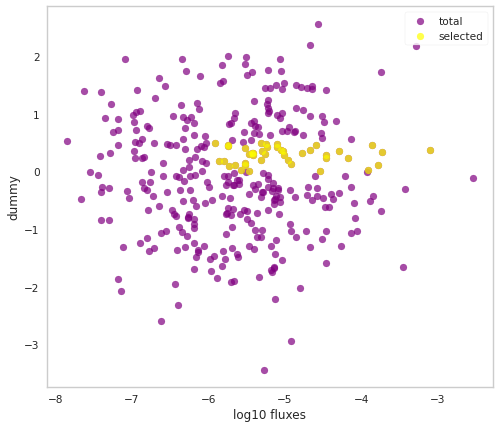Selections
Selections on parameters including flux, distance and any auxiliary variables, can be performed in arbitrarily complex way. We are familiar now with how to add selections onto fluxes and distances, now we will examine in more detail.
built in selection functions
There are several available selection functions:
[1]:
import matplotlib.pyplot as plt
import numpy as np
%matplotlib inline
from jupyterthemes import jtplot
jtplot.style(context="notebook", fscale=1, grid=False)
purple = "#B833FF"
yellow = "#F6EF5B"
import popsynth
popsynth.loud_mode()
popsynth.list_available_selection_functions()
DummySelection
UnitySelection
BernoulliSelection
BoxSelection
LowerBound
UpperBound
SoftSelection
HardFluxSelection
SoftFluxSelection
GalacticPlaneSelection
DistanceSelection
We can use these to set selections on parameters. Let’s add a dummy parameter that is sampled from a normal distribution:
[2]:
aux_parameter = popsynth.NormalAuxSampler(name="dummy", observed=False)
aux_parameter.mu = 0
aux_parameter.sigma = 1
Now we will use the built in Box selection function. Here, we will assign it to an auxiliary sampler, so we need to tell it to select on the observed value:
[3]:
box_select = popsynth.BoxSelection(name="aux_selector", use_obs_value=True)
box_select.vmin = 0
box_select.vmax = 0.5
We can also add on a selection function for the flux
[4]:
flux_select = popsynth.HardFluxSelection()
flux_select.boundary = 1e-6
Now, we can put it all together and create a survey:
[5]:
ps = popsynth.SchechterZPowerCosmoPopulation(
Lambda=50, delta=-2, Lmin=1e52, alpha=1.5, seed=1234
)
aux_parameter.set_selection_probability(box_select)
ps.set_flux_selection(flux_select)
ps.add_auxiliary_sampler(aux_parameter)
pop = ps.draw_survey()
INFO | registering auxilary sampler: dummy
INFO | The volume integral is 371.0099992828878
INFO | Expecting 352 total objects
INFO | Sampling: dummy
INFO | applying selection to fluxes
INFO | Applying selection from dummy which selected 67 of 352 objects
INFO | Before auxiliary selection there were 226 objects selected
INFO | Detected 42 distances
INFO | Detected 42 objects out to a distance of 1.84
[6]:
fig, ax = plt.subplots()
ax.scatter(
np.log10(pop.fluxes_observed), pop.dummy, color="purple", alpha=0.7, label="total"
)
ax.scatter(
np.log10(pop.selected_fluxes_observed),
pop.dummy.selected,
color="yellow",
alpha=0.7,
label="selected",
)
ax.set(xlabel="log10 fluxes", ylabel="dummy")
ax.legend()
WARNING | This will be removed in future versions use x.fluxes
WARNING | This will be removed in future versions use x.fluxes.selected
[6]:
<matplotlib.legend.Legend at 0x7fbc8f349730>

custom selections
we can also create our own custom selection functions.
First, we will look at simply creating a selection. For simplicity, we will look at the Bernoulli selection class built in:
[7]:
class BernoulliSelection(popsynth.SelectionProbability):
# required to register class!
_selection_name = "BernoulliSelection"
# define the parameters to be used
probability = popsynth.SelectionParameter(vmin=0, vmax=1, default=0.5)
def __init__(self) -> None:
super(BernoulliSelection, self).__init__(name="Bernoulli")
def draw(self, size: int) -> None:
"""
The draw function takes an integer for the size of the
samples and sets the private variable _selections which
should be an array of boolean values
"""
self._selection = stats.bernoulli.rvs(
self._probability, size=size).astype(bool) # type: np.ndarray
The procedure can become arbitraliy complex. It is important to note that selections will know about several private variables:
```_observed_value```
```_distance```
```_luminosity```
which enables you to use these values in your selection function.
Because of this, several of the build in selections can be used to select on these variables (though some of this is done in the background for you.)
```python
my_box_selection = popsynth.BoxSelection(name="box_flux_selection", use_flux=True)
my_box_selection.vmin = 1E-4
my_box_selection.vmax = 1E-2
Setting this as the flux selector will select only the fluxes above and below the limits